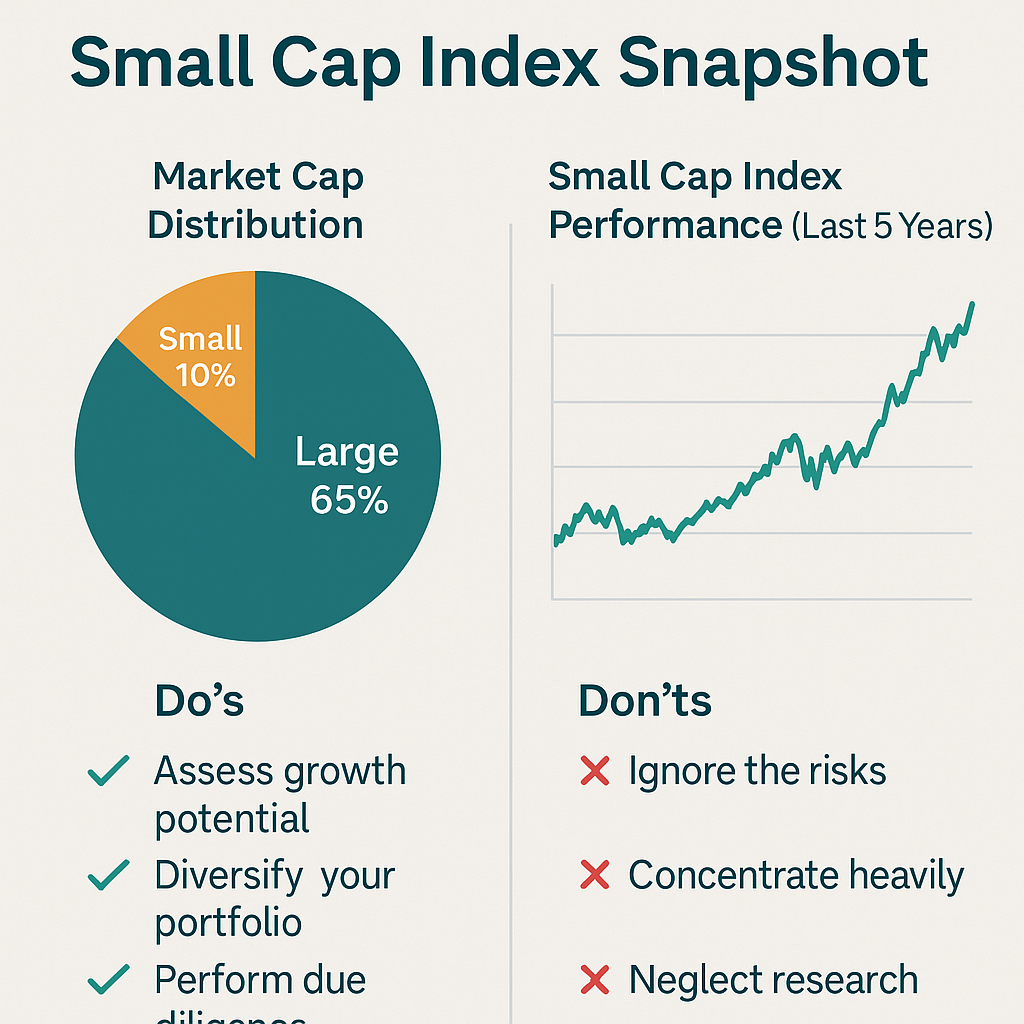Introduction
When it comes to investing in the stock market, most people are familiar with large-cap companies like Reliance Industries, TCS, or Infosys. However, there is a lesser-known segment of the market that holds significant potential for growth: small-cap stocks. These stocks are tracked and measured using a benchmark called the Small Cap Index. This blog post will explain what a Small Cap Index is, why it matters to investors, how it performs compared to other indices, and tips for investing in small-cap stocks.
What is a Small Cap Index?
A Small Cap Index is a stock market index that measures the performance of the smallest companies listed on a stock exchange, usually ranked by market capitalization. These companies are generally newer, in growth stages, and not yet widely recognized by the public.
For instance, in India, the Nifty Smallcap 250 and BSE SmallCap are two widely recognized small-cap indices. The companies listed in these indices typically have a market capitalization between Rs. 500 crore to Rs. 5,000 crore.
Why is the Small Cap Index Important?
- Growth Potential: Small-cap stocks have higher growth potential as they are usually in their early growth phase.
- Market Indicator: It serves as a barometer for the health and sentiment of the broader economy.
- Investment Diversification: Investing in small caps can help diversify a portfolio and reduce dependency on large-cap stocks.
- Opportunity for High Returns: With greater risk comes the possibility of higher returns, which attracts risk-tolerant investors.
Comparison Table: Small Cap vs Mid Cap vs Large Cap
| Feature | Small Cap | Mid Cap | Large Cap |
|---|---|---|---|
| Market Capitalization | Rs. 500 Cr – Rs. 5,000 Cr | Rs. 5,000 Cr – Rs. 20,000 Cr | Above Rs. 20,000 Cr |
| Volatility | High | Medium | Low |
| Liquidity | Low | Medium | High |
| Growth Potential | Very High | High | Moderate |
| Risk Level | High | Medium | Low |
Performance of the Small Cap Index Over the Years
The small-cap segment has seen fluctuating performance over the years. Here’s a snapshot of Nifty Smallcap 250’s performance in recent years:
| Year | Index Value (Start) | Index Value (End) | Annual Return |
| 2020 | 4,300 | 6,200 | +44% |
| 2021 | 6,200 | 9,100 | +46.8% |
| 2022 | 9,100 | 8,300 | -8.7% |
| 2023 | 8,300 | 9,700 | +16.9% |
Despite some down years, the long-term performance shows that small caps can deliver strong returns if chosen wisely.
How are Companies Selected for the Small Cap Index?
Stock exchanges have specific criteria to include companies in the small cap category:
- Market Capitalization: As defined, companies should fall within the lower tier of market caps.
- Liquidity: Stocks must have adequate trading volumes.
- Listing History: Some exchanges require companies to be listed for a certain time period.
- Financial Health: Basic financial metrics and compliance records are also considered.
Advantages of Investing in the Small Cap Index
- Higher Returns: Historically, small-cap indices have outperformed large caps during bullish markets.
- Untapped Potential: Many small-cap companies operate in niche markets with limited competition.
- Better Valuations: Small caps may offer better price-to-earnings ratios, providing value investing opportunities.
- Innovation: These companies are often more agile and open to adopting new technologies or trends.
Risks of Investing in Small Cap Stocks
- High Volatility: Prices can fluctuate drastically in short periods.
- Lower Liquidity: Shares may not be easily tradable, especially in times of market stress.
- Limited Information: Lesser coverage by analysts makes research challenging.
- Management Risk: Limited track record and inexperience can lead to poor decision-making.
Tips for Investing in the Small Cap Index
- Do Thorough Research: Study company fundamentals like balance sheets, business models, and management quality.
- Diversify: Don’t put all your money into small caps. Use them to complement your large and mid-cap investments.
- Stay Invested Long Term: Small caps need time to grow. A long-term horizon improves return potential.
- Use SIPs or Index Funds: Consider mutual funds or ETFs that track the small cap index to reduce individual stock risk.
- Avoid Herd Mentality: Just because a stock is trending doesn’t mean it’s worth investing in.
Popular Small Cap Indices in India
- Nifty Smallcap 250 Index
- BSE SmallCap Index
- Nifty Smallcap 50 Index
These indices track the performance of different subsets of small-cap stocks and are often used by fund managers and retail investors alike.
Small Cap Index Snapshot

Conclusion
The Small Cap Index is a crucial component of the stock market that offers investors a gateway to high-growth opportunities. While these stocks come with increased risks, informed investing and long-term commitment can yield substantial returns. If you’re a retail investor looking to explore beyond blue-chip companies, understanding and leveraging the small cap index can open doors to financial growth. Always remember: higher reward comes with higher risk, so educate yourself, stay updated, and invest wisely.
Call to Action:
Have questions about small cap investing? Drop a comment below or contact us for personalized investment guidance!



